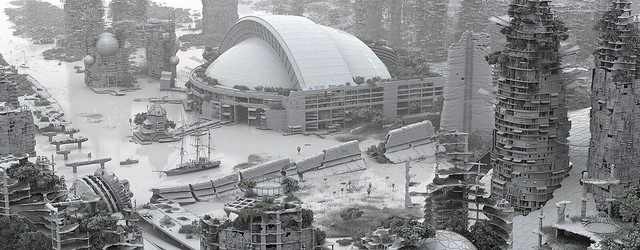
Since the Future Toronto illustration went viral last week there's been a lot of curiosity about what I meant to portray. Here are some of my thoughts on it:
On the origin of "Future Toronto?"
Years ago during a conversation with Matt Blackett of Spacing Magazine, we thought it would be fun to make an image of a drowned Toronto with condo towers poking out of the water and boats tied to them. So when Spacing offered me a double-page spread for its 10th anniversary issue, and gave me carte blanche to propose whatever I wanted - I seized a rare opportunity! I'd been doodling and sketching along the theme of Toronto ruins for years. I wanted to recontextualize the familiar in a startling way. I thought Spacing might reject my early sketches as being too dark for the magazine, but they were excited about it. I had previously done a fallen CN tower illustration for the disaster issue of Spacing and we thought it would be neat to work that into this image too.
Is there a message behind it?
The message was not something that was all that clearly defined in my head as I was doing it. If anything I deliberately wanted it to be kind of ambiguous and perhaps a touch surreal. I wanted it to be complex and not pin it down with a tidy story.
When a friend saw the work in progress he joked that maybe I was channeling the collective anxiety of the city. Maybe so. I was not trying to make a serious statement about the future of the city or where I think its headed.
Some of my inspiration for this future Toronto came from Toronto past. It's hard to imagine that Ashbridges Bay was once a vast marsh and was some of the richest bird habitat on Lake Ontario. Since the founding of "Muddy York", the marsh was gradually defiled by industry and the city's shoreline extended up to a kilometer in some places. Maybe I was imagining some comeuppance for these transgressions on the birds and fish.
How did this future Toronto come into being?
I thought of it as set roughly 150 to 200 years from now. I didn't decide on any one catastrophe having happened, but perhaps just a long period of general instability and decay followed by the beginnings of a renewal. Obviously some kind of climate change has occurred, though not of a nature expected by science. A lot of people have understandably thought the illustration is about global warming and rising ocean levels. However Lake Ontario rising 30ft is not considered a plausible climate change scenario. Honestly, it's just a fictional conceit that looks cool and opened up some fun possibilities for me to play with.
Who lives there?
There's clearly some kind of advanced civilization around, with the power to convert the Skydome into a giant greenhouse and build glassy domes into crumbling condo buildings. One reason I added these sci-fi elements was that early on in the process I'd rendered the Skydome fully in ruins, and since it was so central to the composition, destroying it made the overall image feel much more grim than I wanted. I was very conscious of balancing the apocalyptic with some kind of hopeful renewing force at work.
It was fun to sculpt concrete condo towers into unlikely shapes - so I imagined that these future people had a novel aesthetic sensibility and treated the ruins of today as a giant living sculpture garden. They used special techniques to cultivate fruit trees in unlikely places and coated old concrete structures with smart materials to preserve them from further decay. It's science fiction after all. One can come up with as many conceits as one sees fit!
How is the image being received?
That the image has struck a chord with many people I suspect goes beyond the fact that it's a vivid depiction of the familiar made unfamiliar. Especially interesting to me is that a great number of people feel my future Toronto looks somehow preferable to the one Torontonians presently inhabit. Some wrote things like "I'd move back to Toronto if it looked like that!" I think such responses could have to do with a dissatisfaction with what is often a bland urban environment that rarely engages us as human beings, whereas in my future vision the hard edges are worn down and softened by time and vegetation, and it looks like living there would be full of the kind of adventure and risk that's been sterilized from our present-day urban environment.